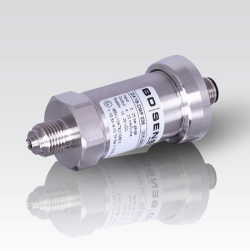
All stainless steel 316L welded wetted parts pressure transmitter for measuring hydrogen gas. The DMP336 is purposely designed for H2 applications which require 316L stainless steel to reduce hydrogen embrittlement of pressure containment components over time, and all welded seals to prevent the leaking of hydrogen gas molecules into the internal electronics housing or the surrounding environment.
Product Parameters
- Pressure Range: 0…16 bar g up to 0…1000 bar g
- Output Signals: 4-20mA, 2 wire
- Accuracy: 0.5% full scale
- Electrical Connections: M12x1 4 pin connector, IP67 cable gland
- Process Connections: G1/2, G1/4 EN837, 1/4 NPT male
- Media Compatibility: All welded stainless steel 316L
- Special Features: H2 gas compatibility, oil and grease free to ISO 15001 for oxygen use
- Special Options: ATEX/IECEx intrinsic safety
Product Description
The use of a thick stainless steel sensing element prevents problems due to hydrogen permeation, where H+ ions can migrate through thin materials such as isolation diaphragm in oil filled silicon pressure sensors. Over time H+ ions will re-combine to form H2 gas molecules which become trapped behind the isolation diaphragm which will eventually causes gas pockets to form within the oil fill causing a shift in sensor calibration.
The DMP 336 wetted parts are manufactured from 316L stainless steel which is the recommended material to use with hydrogen gas to reduce the embrittlement process caused by the absorption of hydrogen ions, and mechanical stresses from high gas pressures.
Hydrogen gas has the smallest molecule, and therefore is the most likely gas to leak through joints and seals. To ensure a high integrity leak tight seal, all materials which are in contact with the hydrogen gas are welded.
Product Help
Preventing hydrogen embrittlement in pressure sensors
I need to measure the pressure of compressed hydrogen, which will be stored in composite pressure vessels on a tube trailer. What material considerations are critical for the pressure sensor to prevent hydrogen embrittlement and ensure long-term operational safety?
When measuring compressed hydrogen, the primary material concern is preventing hydrogen embrittlement. This phenomenon occurs when hydrogen atoms permeate the crystal structure of a metal, such as standard stainless steel, causing it to lose ductility and become brittle. In a high-pressure environment with inherent vibrations, like a mobile tube trailer, this can lead to premature sensor failure and potential safety hazards.
To mitigate this risk, it is essential to select a pressure sensor constructed from a hydrogen-compatible alloy. The DMP 336 series, for instance, utilizes a special stainless steel alloy based on 316L for all media-wetted parts to specifically resist the effects of hydrogen embrittlement.
Furthermore, the sensor’s construction plays a vital role. A fully welded, seal-free design is highly advantageous. This eliminates the use of internal elastomeric or polymer seals, which can be another point of failure as they can degrade, absorb hydrogen, or outgas, compromising both the measurement integrity and the purity of the gas. This robust, dry-cell construction ensures long-term stability and reliability in demanding applications like monitoring hydrogen pressure for transport and refueling stations.
Oil and grease free cleaning for hydrogen pressure sensors
Why is an “oil and grease free” specification necessary for a pressure sensor intended for use with high-purity compressed hydrogen?
An “oil and grease free” cleaning specification is crucial for two main reasons in high-purity hydrogen applications: ensuring safety and preventing contamination.
- Safety and Purity: Any hydrocarbon contaminants, such as oils and greases left over from the manufacturing process, can pose a risk in pressurized gas systems. While this is most critical in oxygen service where hydrocarbons can auto-ignite, maintaining this level of cleanliness for hydrogen is a best practice to prevent any unintended reactions and ensure the purity of the gas.
- Application Contamination: In many hydrogen applications, particularly those involving fuel cells, gas purity is paramount. Trace amounts of hydrocarbons introduced into the hydrogen stream by a contaminated sensor could damage sensitive fuel cell membranes, reducing their efficiency and lifespan. For companies distributing hydrogen for heavy transport, delivering gas of a certified purity is essential.
The DMP 336 series sensor undergoes a special cleaning process to meet the requirements of ISO 15001 for oxygen applications, making it suitable for high-purity hydrogen as well. This process reduces residual contaminants to specified levels (e.g., residual grease content <0.2 mg/dm²) and removes microscopic particles, ensuring the sensor does not contaminate the high-purity hydrogen it is intended to measure.
